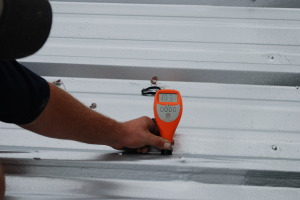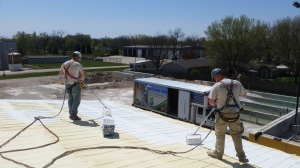Different Types of Roof Coatings: A Guide
Different Types of Roof Coatings: A Guide
Not all roof coatings are the same. In fact, there are many different features and drawbacks for most (if not all) types of coatings. So I thought I would highlight some of the differences in these coatings to clear the air for the average consumer. Let’s begin with the different types:
Acrylics:
Acrylic coatings are the most basic type of coating you will run across – a large section of the coating market is made up of acrylics. Acrylic coatings are very inexpensive and I would venture to guess this is why they are used most often. Acrylic coatings are very similar to common latex paint you can find at any paint store. In fact, most paint stores carry one or more brands of Acrylic Elastomerics. Their downfall is that they are about 50-60% solids. This means that if you put on 20 wet mils, they dry down to about 10 dry mils thickness. Half of your wet coating (and money!) evaporate the day it is installed. Keep in mind standard copy paper is about 8 mils thick.
Depending on the manufacturer, they will require at least two coats of product and will want about 2-3 gallons per 100 square feet. Final dry mil thickness is around 16-20 DFT. The surface will need to be recoated anywhere from five to ten years after the initial installation, depending on how much material the coating contractor actually installs.
Polyureas:
Most polyureas are a two-part mixture applied with a plural component high pressure, high temp, about 150 degrees machine. Most spray-on pickup bed liners are polyureas. Polyureas are high solids, usually around 95% solids. Final dry mils thickness is around 25-40 DFT. Polyurea’s best benefit is that it can be applied very thick in one single application.
 Polyureas do not usually require seam tape or caulking on fasteners like acrylics do. Recoating usually occurs after ten years and depending on initial application thickness can last for as much as twenty years.
Polyureas do not usually require seam tape or caulking on fasteners like acrylics do. Recoating usually occurs after ten years and depending on initial application thickness can last for as much as twenty years.
Silicones:
Silicones apply similarly to acrylics but that is where their similarities end. Silicon has a very high solids level like polyureas. Coverage rates are around 1.5-2 gallons per 100 square feet and end up with a dry mil thickness of 15-20 mils DFT. Silicon is not an organic material and will not wear off like other roof coatings. It leaves a nice gloss-white surface that dirt does not stick well to. It also reflects the heat from the son. Silicon can be easily patched up or touched up later since it is a single component material.
This video demonstrates the application of a silicone primer.
The Key to Coatings
The most important factor regarding any coating is proper preparation of the roof along with installation details. This is where a professional coating contractor comes in. Hiring a guy with a pickup, paintbrush, and ladder doesn’t mean he is trained or a qualified coating contractor. Give us a call and we can help you choose the correct coating for your roof needs!
About the author
Mark grew up in Winterset, Iowa: the birthplace of John Wayne and the home of Madison County Covered Bridges. He lived on a small acreage where they raised cattle, sheep, and chickens. During his youth, he raised and showed cattle with the local 4H program.
Mark’s first paying job was working at the local lumberyard after school and on weekends. After he graduated from Winterset High School he pursued the agricultural field by working on a large farming operation eventually working his way up to the manger position and partner. He also had a long career in the transportation industry.
Mark continues to own and oversee the operations of Iowa Spray Foam in addition to KC Spray Foam & Coatings.
Mark resides in Lee’s Summit, MO with his wife Tina and three of their four children. Their oldest lives and works in the Kansas City area as well.